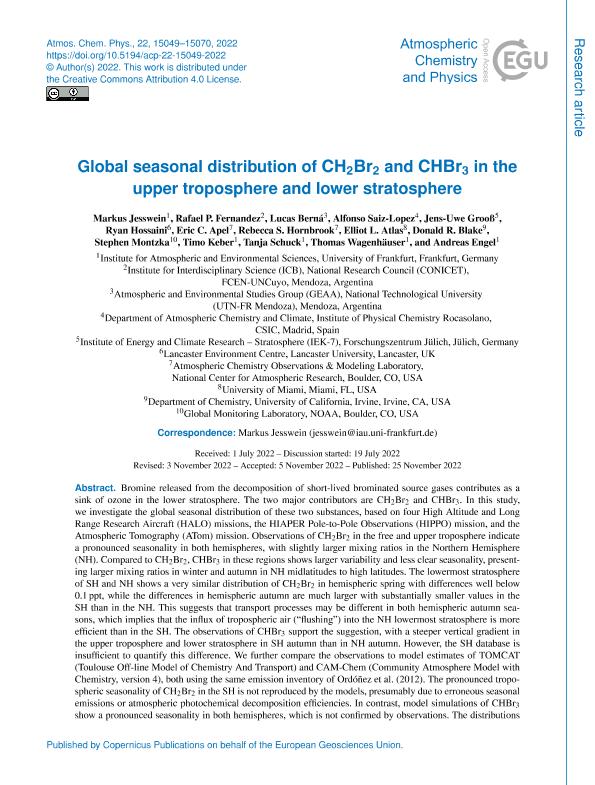Artículo
Global seasonal distribution of CH2Br2 and CHBr3 in the upper troposphere and lower stratosphere
Jesswein, Markus; Fernandez, Rafael Pedro ; Berná Peña, Lucas Luciano
; Berná Peña, Lucas Luciano ; Saiz López, Alfonso; Groob, Jens Uwe; Hossaini, Ryan; Apel, Eric C.; Hornbrook, Rebecca S.; Atlas, Elliot L.; Blake, Donald R.; Montzka, Stephen; Keber, Timo; Schuck, Tanja; Wagenhauser, Thomas; Engel, Andreas
; Saiz López, Alfonso; Groob, Jens Uwe; Hossaini, Ryan; Apel, Eric C.; Hornbrook, Rebecca S.; Atlas, Elliot L.; Blake, Donald R.; Montzka, Stephen; Keber, Timo; Schuck, Tanja; Wagenhauser, Thomas; Engel, Andreas
 ; Berná Peña, Lucas Luciano
; Berná Peña, Lucas Luciano ; Saiz López, Alfonso; Groob, Jens Uwe; Hossaini, Ryan; Apel, Eric C.; Hornbrook, Rebecca S.; Atlas, Elliot L.; Blake, Donald R.; Montzka, Stephen; Keber, Timo; Schuck, Tanja; Wagenhauser, Thomas; Engel, Andreas
; Saiz López, Alfonso; Groob, Jens Uwe; Hossaini, Ryan; Apel, Eric C.; Hornbrook, Rebecca S.; Atlas, Elliot L.; Blake, Donald R.; Montzka, Stephen; Keber, Timo; Schuck, Tanja; Wagenhauser, Thomas; Engel, Andreas
Fecha de publicación:
11/2022
Editorial:
Copernicus Publications
Revista:
Atmospheric Chemistry and Physics
ISSN:
1680-7316
e-ISSN:
1680-7324
Idioma:
Inglés
Tipo de recurso:
Artículo publicado
Clasificación temática:
Resumen
Bromine released from the decomposition of short-lived brominated source gases contributes as a sink of ozone in the lower stratosphere. The two major contributors are CH2Br2 and CHBr3. In this study, we investigate the global seasonal distribution of these two substances, based on four High Altitude and Long Range Research Aircraft (HALO) missions, the HIAPER Pole-to-Pole Observations (HIPPO) mission, and the Atmospheric Tomography (ATom) mission. Observations of CH2Br2 in the free and upper troposphere indicate a pronounced seasonality in both hemispheres, with slightly larger mixing ratios in the Northern Hemisphere (NH). Compared to CH2Br2, CHBr3 in these regions shows larger variability and less clear seasonality, presenting larger mixing ratios in winter and autumn in NH midlatitudes to high latitudes. The lowermost stratosphere of SH and NH shows a very similar distribution of CH2Br2 in hemispheric spring with differences well below 0.1gppt, while the differences in hemispheric autumn are much larger with substantially smaller values in the SH than in the NH. This suggests that transport processes may be different in both hemispheric autumn seasons, which implies that the influx of tropospheric air ("flushing") into the NH lowermost stratosphere is more efficient than in the SH. The observations of CHBr3 support the suggestion, with a steeper vertical gradient in the upper troposphere and lower stratosphere in SH autumn than in NH autumn. However, the SH database is insufficient to quantify this difference. We further compare the observations to model estimates of TOMCAT (Toulouse Off-line Model of Chemistry And Transport) and CAM-Chem (Community Atmosphere Model with Chemistry, version 4), both using the same emission inventory of . The pronounced tropospheric seasonality of CH2Br2 in the SH is not reproduced by the models, presumably due to erroneous seasonal emissions or atmospheric photochemical decomposition efficiencies. In contrast, model simulations of CHBr3 show a pronounced seasonality in both hemispheres, which is not confirmed by observations. The distributions of both species in the lowermost stratosphere of the Northern and Southern hemispheres are overall well captured by the models with the exception of southern hemispheric autumn, where both models present a bias that maximizes in the lowest 40gK above the tropopause, with considerably lower mixing ratios in the observations. Thus, both models reproduce equivalent flushing in both hemispheres, which is not confirmed by the limited available observations. Our study emphasizes the need for more extensive observations in the SH to fully understand the impact of CH2Br2 and CHBr3 on lowermost-stratospheric ozone loss and to help constrain emissions.
Palabras clave:
SOUTH TRAC
,
VSL BROMINE
,
UTLS OZONE
,
CAM-CHEM
Archivos asociados
Licencia
Identificadores
Colecciones
Articulos(CCT - MENDOZA)
Articulos de CTRO.CIENTIFICO TECNOL.CONICET - MENDOZA
Articulos de CTRO.CIENTIFICO TECNOL.CONICET - MENDOZA
Articulos(ICB)
Articulos de INSTITUTO INTERDISCIPLINARIO DE CIENCIAS BASICAS
Articulos de INSTITUTO INTERDISCIPLINARIO DE CIENCIAS BASICAS
Citación
Jesswein, Markus; Fernandez, Rafael Pedro; Berná Peña, Lucas Luciano; Saiz López, Alfonso; Groob, Jens Uwe; et al.; Global seasonal distribution of CH2Br2 and CHBr3 in the upper troposphere and lower stratosphere; Copernicus Publications; Atmospheric Chemistry and Physics; 22; 22; 11-2022; 15049-15070
Compartir
Altmétricas



